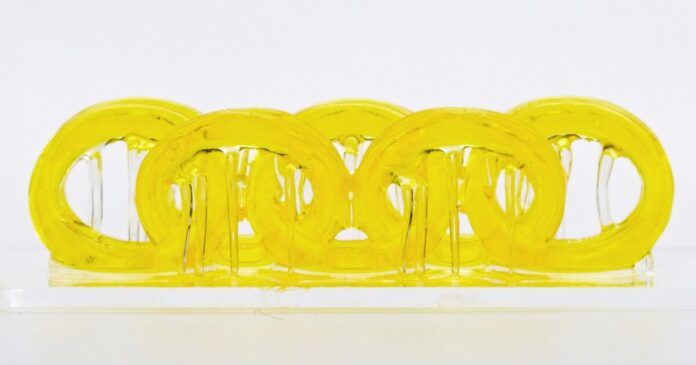If an object that’s composed of two types of material is going to fail, the break will usually occur at the interface where the two meet. A new type of light-activated 3D printing resin addresses that problem, by gradually morphing from hard to soft states within a single object.
Developed by Asst. Prof. Zak Page and colleagues from The University of Texas at Austin, the liquid resin was inspired by natural materials such as rigid bone which smoothly melds with flexible cartilage.
The substance incorporates an epoxy–acrylate monomer combined with a photosensitizer compound. It’s used in a type of 3D printing known as digital light processing (DLP), in which focused patterns of light are shone through the transparent sides of a vat of photosensitive resin – doing so causes select areas of the resin within to polymerize into layers of solid material.
When an area of the new resin is exposed to violet-colored light, the resin in that region forms into a solid yet stretchy rubber-like material. On the other hand, wherever the resin is exposed to ultraviolet light, the photosensitizer in that area causes it to take on a hard, rigid consistency.
And importantly, by softly blending the boundary line between the two types of light, it’s possible to likewise gradually transition from soft rubber to hard polymer within a single print job.
“Nature does this in an organic way, combining hard and soft materials without failure at the interface,” says Page. “We wanted to replicate that.”
The technology has so far been demonstrated in 3D-printed items such as a shock absorber consisting of hard springs embedded in a soft cylinder; a stretchable electronic device with a rigid section to prevent an embedded gold wire from breaking; and a model knee joint featuring both rigid bones and stretchable ligaments.
Possible future applications could include surgical training models, wearable sensors, or perhaps even soft-bodied robots.
Model knee joint made from single dual-nature 3D-printing resin
It should be mentioned that scientists at Case Western Reserve University previously developed a somewhat similar material, inspired by squid beaks, which can be made harder or softer by varying the amount of light it’s exposed to.
And more recently, researchers from the University of California Santa Barbara and the Lawrence Livermore National Laboratory created a resin that can form a permanent or dissolvable solid, depending on whether it’s exposed to ultraviolet or visible light.
A paper on the UT Austin resin was recently published in the journal Nature Materials.


